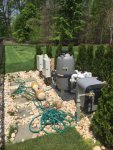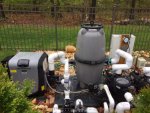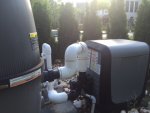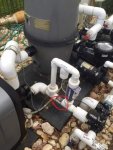CO2 injection will lower the pH without significantly increasing TA. It's fairly common to use in large commercial pools where adding acid might be to dangerous or difficult. It is only very rarely used in residential pools as the cost of gas and the setup required would be a bit too much. There is a pool service company here in AZ that does weekly chlorine gas injection as their method of pool care and they use CO2 to lower pH as well.
I've bought a Stenner pump and tank but haven't hooked it up yet. Mainly derailed by the fact my Pentair Inetlliflow sometimes stops after momentary power interruptions even though it still has power applied to it so I can't depend on powering both from the same switch. I now have a relay switched by a CT so I can run the Intelluiflow power cord through the CT (current transformer) so when the Intelliflow stops drawing power it will cut power to the Stenner pump but I haven't gotten back on this project and was reading about CO2 injection. I see the opinions that it is too expensive for home use but can someone help me understand that?
Maybe some data I'm looking at is wrong: I've read a pound of CO2 (about 8.75 SCF) will lower PH about the same as 1/4 gallon of Muriatic Acid. Is that true?
My pool normally demands about 30 ounces of Muriatic Acid when PH rises to 7.8 which is very often - almost daily - when hot and I'm adding a lot of calhypo (avoiding excess cyanuric acid buildup) so that would seem to be equivalent to about a pound of CO2. The cheapest I can find Muriatic Acid is about $5.50 so the costs seem similar. CO2 might even be a little less in larger cylinders.
Now for my more detailed questions: 1 pound in 24 hours is only .36 SCFH. 1/3 a cubic foot per hour is a "very slow flow rate" and probably not feasible anyway but is there some trick to CO2 injection that requires perhaps a higher flow? Obviously the pressure must be higher than the pressure in the pipe it's injected into but would a tiny dribble of bubbles of CO2 be dissolved into the water if injected at a pressure barely above the water pressure? From my injection point to pool inlets is about 25 feet in one direction and maybe 60 feet in the other so plenty of time to be absorbed I'd think but maybe not? I see the Hayward units offering flow rates of 30 and 100 SCFH and wonder if my calculations are totally off?
Those controllers - even the smaller 30 SCFH one - (which are for residential pools) could inject more CO2 in an hour than my calculations indicate I'd need in almost 4 days so this makes me think I might be way off or perhaps the nature of CO2 injection "requires" a higher pressure higher flow rate injection through perhaps a venturri creating shearing forces or turbulence in the mixing operation?
If it must be injected fast then how fast? How many cubic feet per minute (or hour) is required? Those ontrollers have solenoids to turn the higher flow on and off to modulate injcetion so they could stay off most of the time and deliver the 8.75 CF per day I think I need.
My current problem manually adding acid is that even when I divide 30 ounces into 3 or 4 pours diluted in a 5 gallon pail around the pool edges it still lowers TA back down to aboyt 60 (from 90 -100) in about a week so my attraction to CO2 is mainly to avoid lowering TA and this constant battle adding baking soda to raise TA followed by acid to lower PH (not same day of coures).
I am used to refilling Co2 cylinders since I keep beer on tap at home but if I go this route I'd probably get a little larger cylinder than the 20 pounders since they might not last a month. Then again a 20 pounder might very well last a month since I'd probably not need as much acid if I weren't adding all the baking soda to control TA.
I would appreciate advice since all my Stenner stuff (pump tank, etc is new) and I could sell it and switch to CO2 if feasible but if it definitely isn't I need to install it since I "hope" slower injection of acid ( say 30 ounces dribbled in over 24 hours) will stop dropping my TA as much.
Thanks,
Nick





